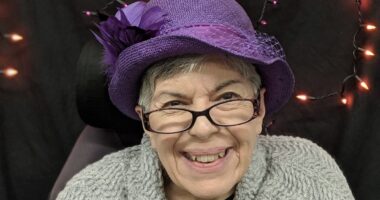A safe space where LGBTQ+ and Disability Pride meet
My doctors demonstrated the correct way to provide a supportive environment

Upon diagnosis, caregivers and SMA patients are often warned to watch the patient’s respiratory system. The weakening of this most basic function of the human body is the most common cause of death for people like myself.
Hence, regular pulmonary exams are done, physiotherapists are called in to teach breathing exercises, and if necessary, ventilators are prescribed for sleep or 24/7 use. One day or night struggling to breathe, for whatever reason, is all it takes for our lungs to collapse, potentially taking our lives with them.
This was all I could think about when I arrived home from an assessment by my neurologist and pain specialist. I drew in a deep breath and exhaled slowly, a sigh of relief. All was well. Even better, during the appointment, I had come out to them as bisexual. They were so accepting and unexpectedly casual about it that I felt like my lungs could breathe more easily, like they somehow had been strengthened.
Acceptance is life-sustaining
Despite being vulnerable in my writing, I like to think that I do a good job of compartmentalizing my life. I switch hats as needed, as a columnist, daughter, friend, patient, sister, and more. I project a different image for each of them, different facets of my personality that people may or may not see.
I try not to deviate from the lines I’ve drawn, to never accidentally let the wrong people perceive the wrong facets of me. It’s more for my sake than theirs, as I’m comfortable playing the part that each audience expects of me. But no one is perfect, so lines do blur and fragments do slip through cracks.
I crafted the patient me as mostly a quiet subject (unless healthcare professionals assume they know my condition better than me). She is polite and professional. Her goal is to get examinations and treatments over and done with. Only the parts of my personal life that are relevant to my medical history are presented for study.
On the day I came out to my doctors, I didn’t intend to reveal that I’m queer. Usually, that part of me — which questions my gender and the norms surrounding it, celebrates falling in love with women, and goes to Pride rallies, called Pink Dot here in Singapore, where I live — is reserved for my friends and my writing. It typically has more to do with the expression of my social life and my creativity.
But because relationships impacted by my queerness were causing me distress at the time, my chronic pain was exacerbated by the tension I was holding in my body. So I broke down and explained what I was going through. The sobbing was devastating, leaving me gasping for air until my pain specialist squeezed my wrist to comfort me.
I’d been so used to putting up a certain front and being perceived in a certain way by my doctors that it shocked me how casually my pain specialist and neurologist received the information. I expected them to be horrified. Instead, they shrugged and told me they’d do their best to support me and create a safe space where I could be myself. It was like a rush of oxygen and an overwhelming calmness after years of holding my breath.
As we leave Pride Month behind and begin Disability Pride Month, I’m sharing this experience of mine to remind everyone how healthcare professionals can and should create a safe and supportive environment for queer SMA patients. Even if patients don’t see how their queerness might affect their medical history, it actually can. So the people treating them should be trusted enough with that information. Because you never know — it just might save a life.
Note: SMA News Today is strictly a news and information website about the disease. It does not provide medical advice, diagnosis, or treatment. This content is not intended to be a substitute for professional medical advice, diagnosis, or treatment. Always seek the advice of your physician or other qualified health provider with any questions you may have regarding a medical condition. Never disregard professional medical advice or delay in seeking it because of something you have read on this website. The opinions expressed in this column are not those of SMA News Today or its parent company, Bionews, and are intended to spark discussion about issues pertaining to spinal muscular atrophy.








Leave a comment
Fill in the required fields to post. Your email address will not be published.